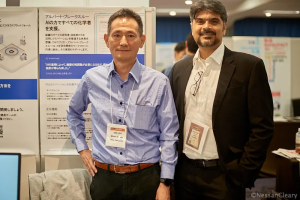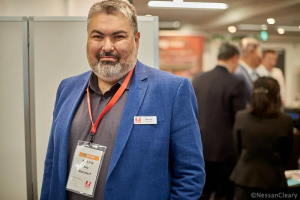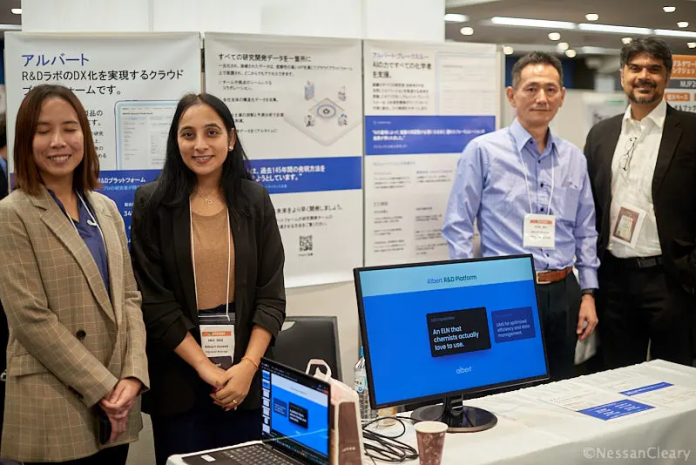This is the second part of my review from the Japan Inkjet Technology Forum (JITF), which was held in Tokyo at the end of October. In the first part I covered the printhead vendors at the show, finishing up with Meteor Inkjet, which develops electronics to drive those heads, and is increasingly moving into print control software.
For this story I’m going to continue with the software theme. One of the advantages of this kind of event is the opportunity to stumble across companies that I had not met before, such as Albert Invent. This company has developed the Albert software platform that helps materials science chemists chose the best materials for their project. Essentially it’s a database of different materials and their physical properties and industry standards, combined with cloud computing and AI to help predict how each material will work for a given situation.
The advantage is that it takes a lot of time and cost out of the early R&D stage for a range of different projects, such as ink and fluid development, or 3D printing materials. Sreedhar Arumugam, managing director of Albert, says, “Our focus is on how many iterations you used and we will help you to reduce that.”

From left: Hiro Takeuchi, managing director of Albert Japan; and Sreedhar Arumugam, managing director of Albert. Photo Nessan Cleary
The company grew out of a 3D printing start-up project that was acquired by Henkel in 2019. Henkel then helped further develop the Albert software side so that this could be spun off as a separate business. Henkel still remains one of the largest customers for Albert, with Arumugam noting, “Our focus is on the larger companies because the smaller ones will follow.” He added, “We wanted to be present here because we can help the industry in the digital transformation.”
Adobe
Adobe focused its efforts at JITF on end to end workflows based around its PDF print engine. Shigera Masuda, senior OEM product manager for Adobe, says that there are still many users, particularly in the textiles and packaging markets that use other formats such as TIFF or PNG who would benefit from outputting PDFs from their design software and using those PDFs right through the workflow from production to finishing.
I covered the current iteration of APPE 6 in more detail when it was first introduced two and a half years ago, but Masuda says that Adobe has added some improvements, particularly around handling separate layers. Thus it can now automatically add a white layer behind a design. This has an obvious benefit for DtG and DtF printing as it takes out some of the design skills needed for printing to darker materials for t-shirts and similar applications.

He argues that this also allows packaging customers to enhance their designs with separate layers for varnishes and for white ink. The Adobe software will allow users to choose how close they want to match the white layer to the shape of the colours of a design, or how thick they want to print a varnish layer.
APPE6 supports CFX spectral data for managing spot colours and generating accurate colour conversions. The PDFs can also hold post printing data so that a single PDF file can be used at all stages of production.
Adobe also discussed its Express cloud-based service which gives users free access to design software to create designs and add them to a template.
Fiery
Fiery made its debut at JITF this year and mainly promoted its Impress DFE, which is targeted more at the growing industrial inkjet market. Most Fiery RIPs have been developed to match the needs of specific printers. But Marcelo Tomoyose, global business development for industrial inkjet, explained, “In 2022 we started a product to compile all the tools into one product and we expose a set of APIs so any press manufacturer can connect their presses.”
He added, “Because of this we developed some strategic partnerships to help us and our customers to move forward in their markets.” This includes GIS, to give a tight integration with drive electronics, as well as Esko, which is mainly to integrate the Fiery tools into packaging workflows. The Esko partnership will allow existing users to use Esko Color and hand over the colour management information directly to the Fiery engine for smoother colour conversions. He adds that Fiery is also targeting specialty markets through its CadLink acquisition.

The German software company Sofha, which was founded in Berlin in 1981, also made its first appearance at the JITF event this year. The company has developed a number of printer drivers and front end software for several OEM press manufacturers. This includes the DFE for Konica Minolta’s KM1e B2 sheetfed inkjet press. Sofha has had a long history of working with Konica Minolta since at least 2004 and the two companies established a close strategic alliance in 2015.
Sofha has been a co-development partner of Adobe’s since 1994 and an Adobe APPE licensee since 2008, with Mona Hansen, CEO of Sofha, noting, “So, we have access to all their technology and build our own platform on top of that to do things that you don’t get out of the box.”
She adds, “We are not just taking Adobe technology. We are looking at how we can optimize things. The performance should be scalable so our software architecture is designed for this. We can run multiple instances of APPE. We can extend this further by clustering so if a customer needs more than we can add another hardware.”

She continues, “And we can save our OEMs quite a bit of time in learning how to get the best performance. We go across the whole spectrum from light production, commercial printing, production printing, industrial printing. We have had customers that do packaging in the past. We integrate with whoever we can.”
Naturally I asked her about Epson’s acquisition of Fiery and Hansen told me, “We are a strong competitor to Fiery.” She added, “We think it will be good for us if people are worried that Epson might not want to supply DFEs to other companies. And we don’t do the same type of business. Fiery has their own branded products but we will supply whatever our OEMs need. If they want something and it’s possible to build it then we will make it.”
Later, Adobe’s Masuda told me, “We have a very close relationship with Fiery and Sofha because they are using our technology in their products. We are meeting with potential customers who need their solutions. It can be difficult to rely on online communications but here we are face-to-face so it’s easy for us to introduce them. It’s very casual and that’s a very big benefit. This kind of interactive event is almost unheard of in Japan.”

It’s a good point because although the Japanese industry is punching above its weight in terms of hardware, particularly production presses and printheads, it does seem to me that there is more of a gap in terms of software. Yet it is becoming increasingly obvious that inkjet requires very tight integration between the software and the hardware right down to the printheads and I would expect to see more software companies making their way to the Japanese market.
Overall, my impression was that this was reflected at the event with a greater emphasis on software at this year’s JITF than in previous years. And the fact that a Japanese company – Epson – now owns Fiery, which is one of the main software developers, was a major talking point at the show. It’s still too early to say what impact this acquisition will really have on the industry overall so people will continue to speculate on this subject into next year.
You can find the first part of this story here, with the third part to come next week. In the meantime, I’m going to take a few days off for Christmas so it only remains for me to wish everyone ‘Happy Holidays’.
First published in the Printing and Manufacturing Journal on 24 December 2024. Republished with permission.















